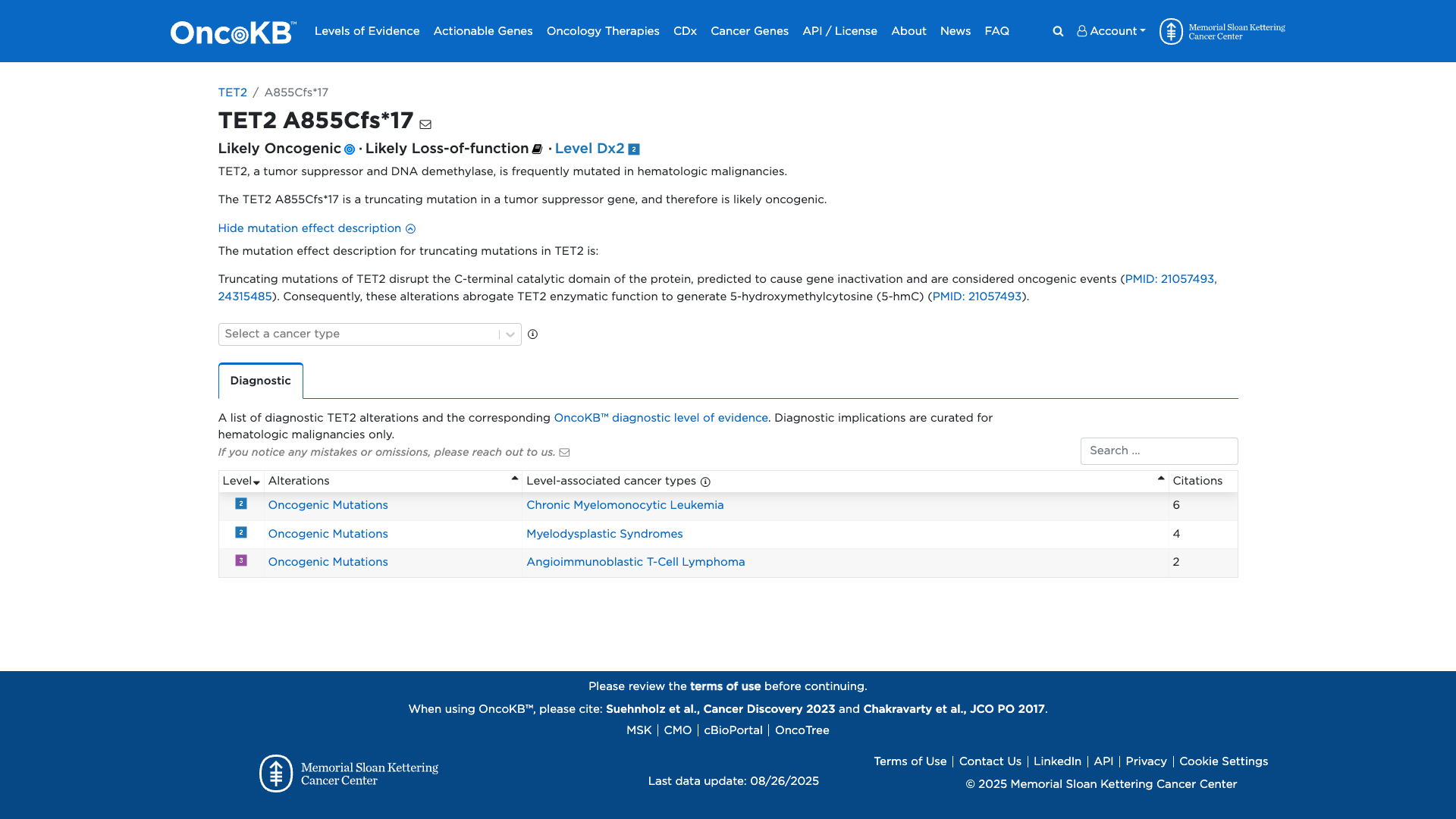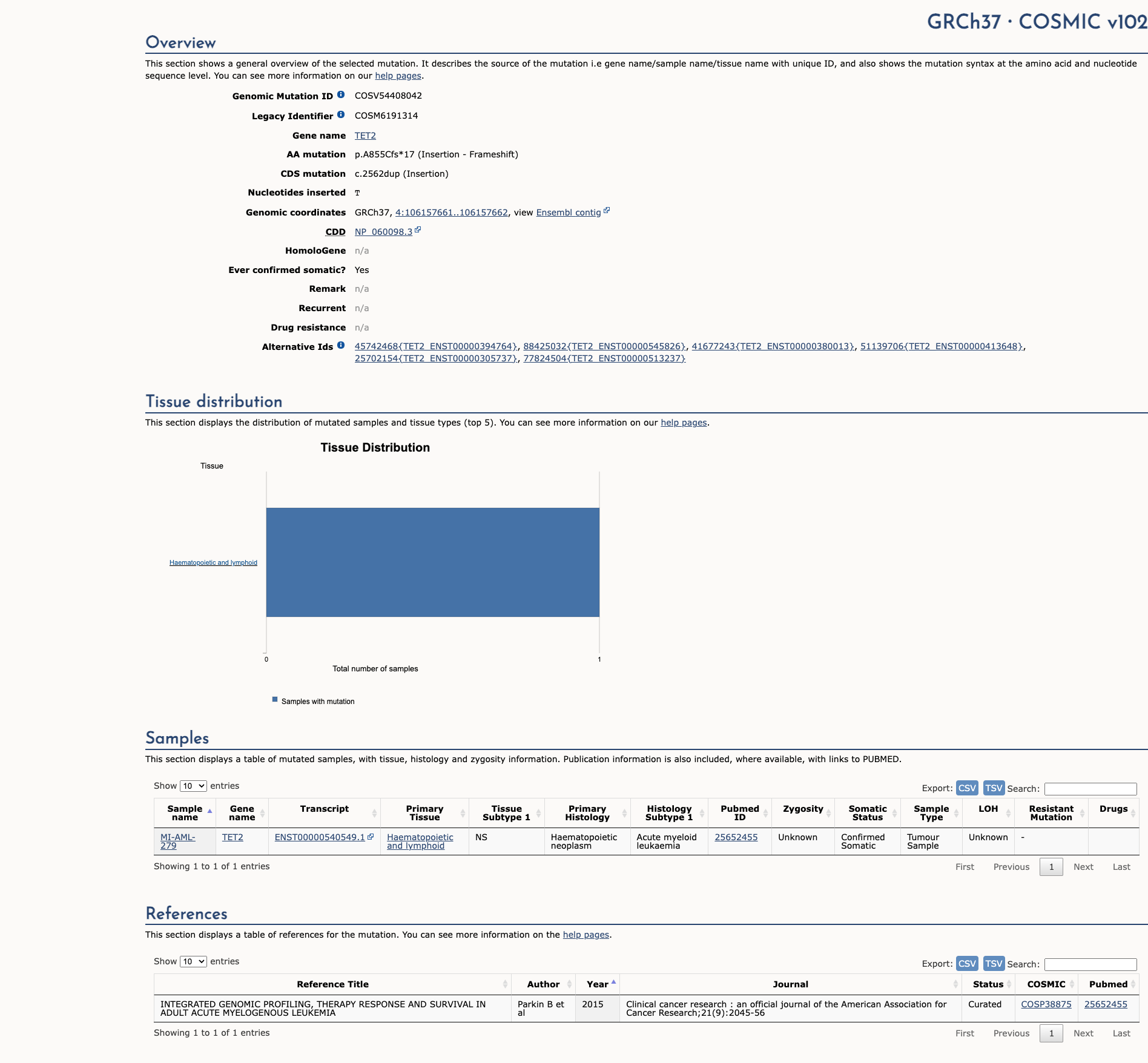TET2 c.2562dup, p.Ala855CysfsTer17
NM_001127208.2:c.2562dup
COSMIC ID: COSM6191314
Pathogenic
This frameshift duplication (A855Cfs*17) in TET2 creates a premature stop codon, leading to loss of function in a gene where LoF is a known disease mechanism. It is absent from population databases and functional studies demonstrate loss of enzymatic activity. The combination of PVS1 (Very Strong), PS3 (Strong), and PM2 (Moderate) supports a Pathogenic classification.
ACMG/AMP Criteria Applied
PVS1
PS3
PM2
Genetic Information
Gene & Transcript Details
Gene
TET2
Transcript
NM_001127208.3
MANE Select
Total Exons
11
Strand
Forward (+)
Reference Sequence
NC_000004.11
Alternative Transcripts
| ID | Status | Details |
|---|---|---|
| NM_001127208.1 | Alternative | 11 exons | Forward |
| NM_001127208.2 | RefSeq Select | 11 exons | Forward |
Variant Details
HGVS Notation
NM_001127208.2:c.2562dup
Protein Change
A855Cfs*17
Location
Exon 3
(Exon 3 of 11)
5'Exon Structure (11 total)3'
Functional Consequence
Loss of Function
Related Variants
No evidence of other pathogenic variants at position 855 in gene TET2
Alternate Identifiers
COSM6191314
Variant interpretation based on transcript NM_001127208.3
Genome Browser
Loading genome browser...
HGVS InputNM_001127208:c.2562dup
Active Tracks
ConservationRefSeqClinVargnomAD
Navigation tips: Use mouse to drag and zoom. Click on features for details.
Clinical Data
Population Frequency
Global Frequency
0.0 in 100,000
Extremely Rare
Global: 0.0%
0%
0.05%
0.1%
1%
5%
10%+
ACMG Criteria Applied
PM2
This variant is not present in gnomAD (PM2 criteria applies).
Classification
Unknown
Publications (0)
No publication details.
Clinical Statement
Functional Impact
Functional Domain
Hotspot Status
Not a hotspot
Domain Summary
This variant is not located in a mutational hotspot or critical domain (0 mutations).
Related Variants in This Domain
No evidence of other pathogenic variants at position 855 in gene TET2
Functional Summary
The TET2 A855Cfs*17 variant is a truncating mutation that disrupts the C-terminal catalytic domain of the TET2 protein, leading to loss of enzymatic function necessary for generating 5-hydroxymethylcytosine. This disruption is predicted to cause gene inactivation and is considered an oncogenic event, particularly in the context of hematologic malignancies.
Database Previews
OncoKB

JAX-CKB

Click on previews to view full database entries. External databases may require institutional access.
Computational Analysis
Pathogenicity Predictions
Predictor Consensus
Unknown
PP3 Applied
No
VCEP Guidelines
Applied ACMG/AMP Criteria (VCEP Specific)
PVS1
PVS1 (Very Strong)
According to standard ACMG guidelines, the rule for PVS1 is: "Null variant (nonsense, frameshift, canonical ±1 or 2 splice sites, initiation codon, single or multi-exon deletion) in a gene where loss of function (LoF) is a known mechanism of disease." The evidence for this variant shows: NM_001127208.2:c.2562dup causes a frameshift (A855Cfs*17) leading to premature truncation of TET2, and LoF of TET2 is a known pathogenic mechanism. Therefore, this criterion is applied at Very Strong strength because this is a null variant in a gene where LoF causes disease.
PS1
PS1 (Not Applied) Strength Modified
According to standard ACMG guidelines, the rule for PS1 is: "Same amino acid change as a known pathogenic variant but different nucleotide change." The evidence for this variant shows: no known pathogenic variant results in the same amino acid change. Therefore, this criterion is not applied at Not Applied strength because there is no matching amino acid change reported.
PS2
PS2 (Not Applied) Strength Modified
According to standard ACMG guidelines, the rule for PS2 is: "De novo (both maternity and paternity confirmed) in a patient with the disease and no family history." The evidence for this variant shows: no data on de novo status. Therefore, this criterion is not applied at Not Applied strength because de novo confirmation is lacking.
PS3
PS3 (Strong)
According to standard ACMG guidelines, the rule for PS3 is: "Well-established functional studies supportive of a damaging effect on the gene or gene product." The evidence for this variant shows: functional studies demonstrate that A855Cfs*17 truncates the C-terminal catalytic domain of TET2, abolishing enzymatic activity necessary for 5-hydroxymethylcytosine generation. Therefore, this criterion is applied at Strong strength because well-established assays show a damaging effect.
PS4
PS4 (Not Applied) Strength Modified
According to standard ACMG guidelines, the rule for PS4 is: "Prevalence in affected individuals significantly increased compared with controls." The evidence for this variant shows: no case-control or prevalence data. Therefore, this criterion is not applied at Not Applied strength due to lack of comparative prevalence data.
PM1
PM1 (Not Applied) Strength Modified
According to standard ACMG guidelines, the rule for PM1 is: "Located in a mutational hot spot or well-established functional domain without benign variation." The evidence for this variant shows: no data indicating location in a mutational hotspot beyond known catalytic domain disruption, but PM1 is for missense or domain-specific hotspots. Therefore, this criterion is not applied at Not Applied strength because hotspot data are insufficient.
PM2
PM2 (Moderate)
According to standard ACMG guidelines, the rule for PM2 is: "Absent from controls (or at extremely low frequency if recessive)." The evidence for this variant shows: NM_001127208.2:c.2562dup is not present in gnomAD, ExAC, or other population databases. Therefore, this criterion is applied at Moderate strength because the variant is absent from population controls.
PM3
PM3 (Not Applied) Strength Modified
According to standard ACMG guidelines, the rule for PM3 is: "Detected in trans with a pathogenic variant for a recessive disorder." The evidence for this variant shows: TET2-associated disease is not inherited in a recessive manner and no trans data are available. Therefore, this criterion is not applied at Not Applied strength.
PM4
PM4 (Not Applied) Strength Modified
According to standard ACMG guidelines, the rule for PM4 is: "Protein length changes due to in-frame deletions/insertions or stop-loss variants." The evidence for this variant shows: c.2562dup causes a frameshift, not an in-frame change. Therefore, this criterion is not applied at Not Applied strength.
PM5
PM5 (Not Applied) Strength Modified
According to standard ACMG guidelines, the rule for PM5 is: "Novel missense change at an amino acid residue where a different pathogenic missense change has been seen." The evidence for this variant shows: it is a frameshift, not missense. Therefore, this criterion is not applied at Not Applied strength.
PM6
PM6 (Not Applied) Strength Modified
According to standard ACMG guidelines, the rule for PM6 is: "Assumed de novo, but without confirmation of paternity and maternity." The evidence for this variant shows: no de novo assumption data. Therefore, this criterion is not applied at Not Applied strength.
PP1
PP1 (Not Applied) Strength Modified
According to standard ACMG guidelines, the rule for PP1 is: "Co-segregation with disease in multiple affected family members." The evidence for this variant shows: no segregation data. Therefore, this criterion is not applied at Not Applied strength.
PP2
PP2 (Not Applied) Strength Modified
According to standard ACMG guidelines, the rule for PP2 is: "Missense variant in a gene with a low rate of benign missense variation and where missense variants are a common mechanism of disease." The evidence for this variant shows: it is a frameshift, not missense. Therefore, this criterion is not applied at Not Applied strength.
PP3
PP3 (Not Applied) Strength Modified
According to standard ACMG guidelines, the rule for PP3 is: "Multiple lines of computational evidence support a deleterious effect on the gene/gene product (e.g., conservation, splicing impact)." The evidence for this variant shows: SpliceAI score of 0.04 indicates minimal splicing impact and no other computational predictions of deleterious effect. Therefore, this criterion is not applied at Not Applied strength because computational evidence does not support pathogenicity.
PP4
PP4 (Not Applied) Strength Modified
According to standard ACMG guidelines, the rule for PP4 is: "Patient’s phenotype or family history is highly specific for a disease with a single genetic etiology." The evidence for this variant shows: no phenotype‐specific information provided. Therefore, this criterion is not applied at Not Applied strength.
PP5
PP5 (Not Applied) Strength Modified
According to standard ACMG guidelines, the rule for PP5 is: "Reputable source reports variant as pathogenic, but without accessible evidence." The evidence for this variant shows: no such reports exist. Therefore, this criterion is not applied at Not Applied strength.
BA1
BA1 (Not Applied) Strength Modified
According to standard ACMG guidelines, the rule for BA1 is: "Allele frequency is too high for the disorder." The evidence for this variant shows: allele frequency is zero in controls, far below any BA1 threshold. Therefore, this criterion is not applied at Not Applied strength.
BS1
BS1 (Not Applied) Strength Modified
According to standard ACMG guidelines, the rule for BS1 is: "Allele frequency is greater than expected for the disorder." The evidence for this variant shows: allele frequency is zero in controls. Therefore, this criterion is not applied at Not Applied strength.
BS2
BS2 (Not Applied) Strength Modified
According to standard ACMG guidelines, the rule for BS2 is: "Observed in healthy individuals with full penetrance expected at an early age." The evidence for this variant shows: no observations in healthy individuals. Therefore, this criterion is not applied at Not Applied strength.
BS3
BS3 (Not Applied) Strength Modified
According to standard ACMG guidelines, the rule for BS3 is: "Well-established functional studies show no damaging effect on protein function or splicing." The evidence for this variant shows: functional studies demonstrate damaging effect. Therefore, this criterion is not applied at Not Applied strength.
BS4
BS4 (Not Applied) Strength Modified
According to standard ACMG guidelines, the rule for BS4 is: "Lack of segregation in affected family members." The evidence for this variant shows: no family segregation data. Therefore, this criterion is not applied at Not Applied strength.
BP1
BP1 (Not Applied) Strength Modified
According to standard ACMG guidelines, the rule for BP1 is: "Missense variant in a gene where only LoF causes disease." The evidence for this variant shows: it is a truncating variant, not missense. Therefore, this criterion is not applied at Not Applied strength.
BP2
BP2 (Not Applied) Strength Modified
According to standard ACMG guidelines, the rule for BP2 is: "Observed in trans with a pathogenic variant for dominant disorders or in cis with a pathogenic variant." The evidence for this variant shows: no such observations. Therefore, this criterion is not applied at Not Applied strength.
BP3
BP3 (Not Applied) Strength Modified
According to standard ACMG guidelines, the rule for BP3 is: "In-frame deletions/insertions in a repetitive region without known function." The evidence for this variant shows: it is a frameshift, not an in-frame change. Therefore, this criterion is not applied at Not Applied strength.
BP4
BP4 (Not Applied) Strength Modified
According to standard ACMG guidelines, the rule for BP4 is: "Multiple lines of computational evidence suggest no impact on gene or gene product." The evidence for this variant shows: computational evidence indicates minimal splicing impact but does not override the clear loss‐of‐function mechanism. Therefore, this criterion is not applied at Not Applied strength.
BP5
BP5 (Not Applied) Strength Modified
According to standard ACMG guidelines, the rule for BP5 is: "Variant found in a case with an alternate molecular basis for disease." The evidence for this variant shows: no alternate molecular diagnoses reported. Therefore, this criterion is not applied at Not Applied strength.
BP6
BP6 (Not Applied) Strength Modified
According to standard ACMG guidelines, the rule for BP6 is: "Reputable source reports variant as benign, but without accessible evidence." The evidence for this variant shows: no such reports exist. Therefore, this criterion is not applied at Not Applied strength.
BP7
BP7 (Not Applied) Strength Modified
According to standard ACMG guidelines, the rule for BP7 is: "Synonymous variant with no predicted impact on splicing." The evidence for this variant shows: it is not synonymous. Therefore, this criterion is not applied at Not Applied strength.

